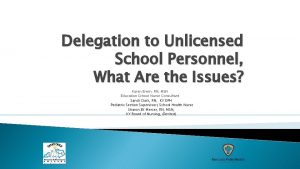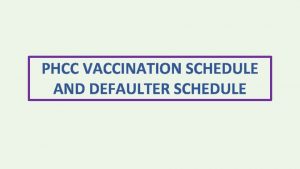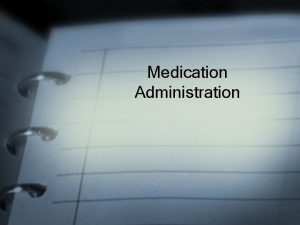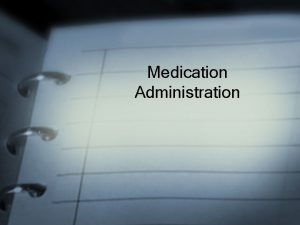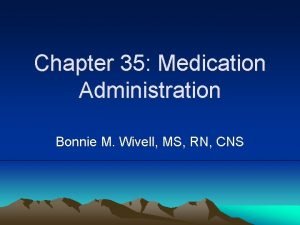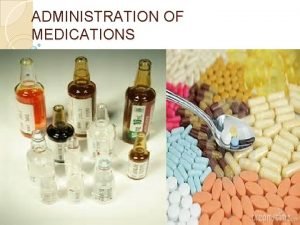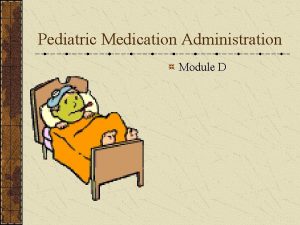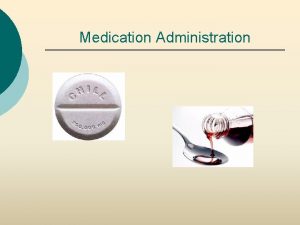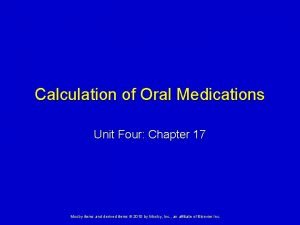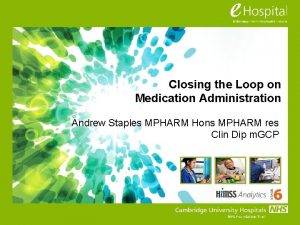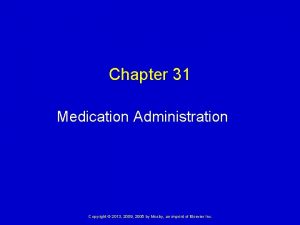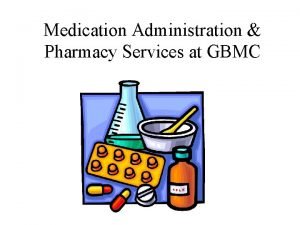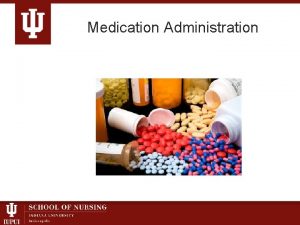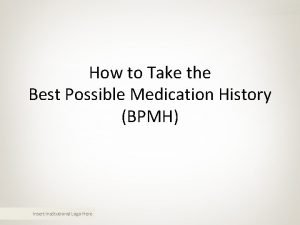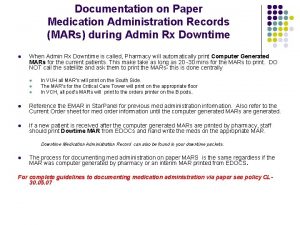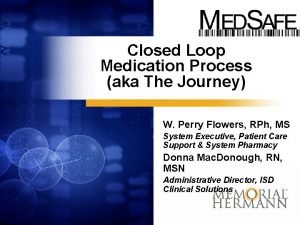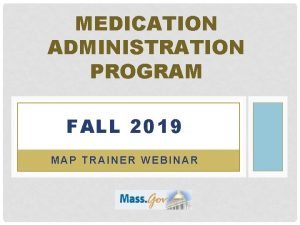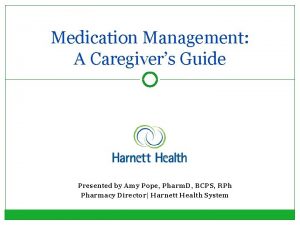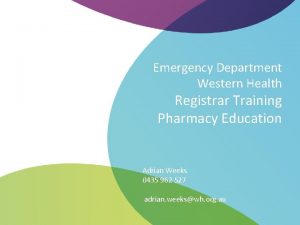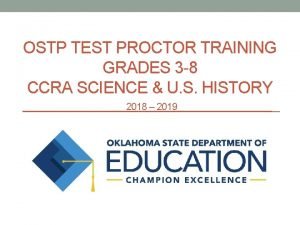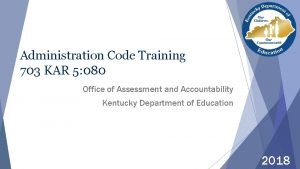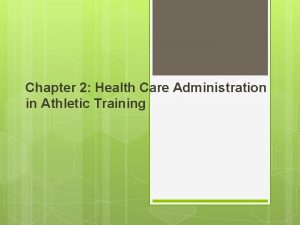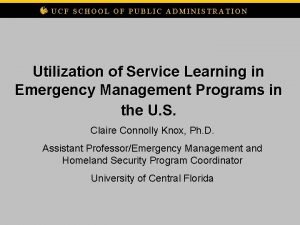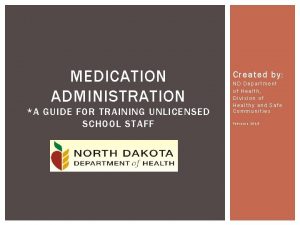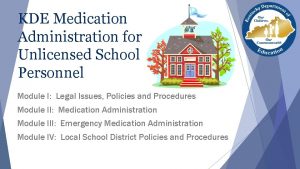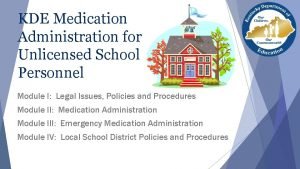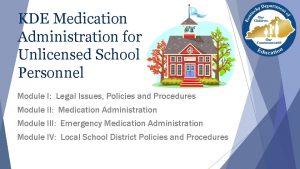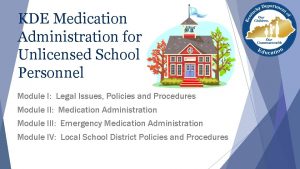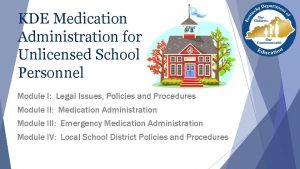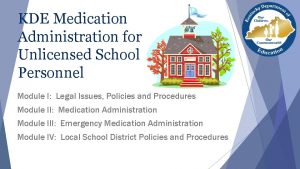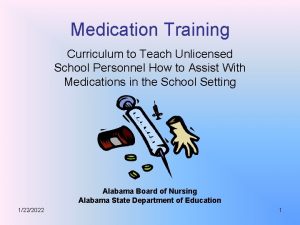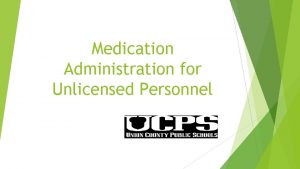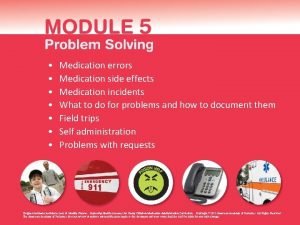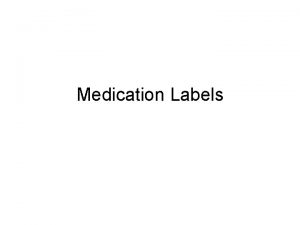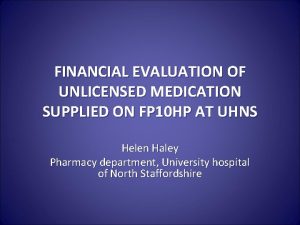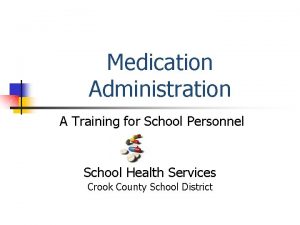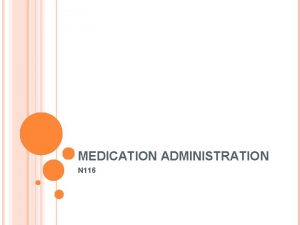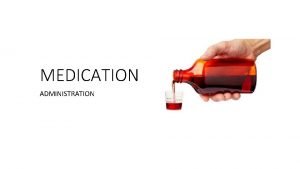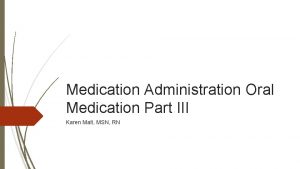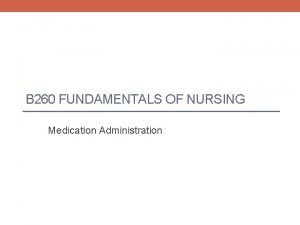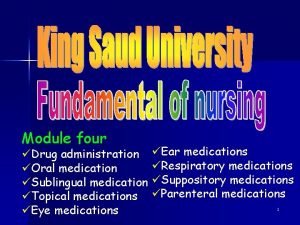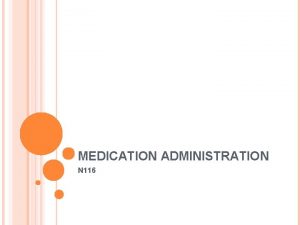MEDICATION ADMINISTRATION A GUIDE FOR TRAINING UNLICENSED SCHOOL










































































- Slides: 74

MEDICATION ADMINISTRATION *A GUIDE FOR TRAINING UNLICENSED SCHOOL STAFF Created by: ND Department of Health, Division of Healthy and Safe Communities February 2016

REVIEWED BY: The following information has been reviewed and approved by: North Dakota Department of Health (NDDo. H) North Dakota Department of Public Instruction (DPI) North Dakota Board of Nursing (NDBON) A cross-section of ND school nurses

OBJECTIVES Participants will have an understanding of the ND State Statutes regarding medication administration in schools. Participants will understand what paperwork is needed to safely administer medications in school and document the delivery of these medications. Participants will be able to verbalize the six rights of medication administration. Participants will know best practices of storing, handling and disposing of medications in the school setting. Participants will successfully complete a hands-on return demonstration of medication administration.

PURPOSE The purpose of this Power. Point presentation is to provide a guideline to aide in training non-licensed school personnel in medication administration. § Student’s safety when administering medications is always the MAIN priority.

NORTH DAKOTA STATE STATUTES § ND state statute 15. 1 -19 -23 reads as follows § 15. 1 -19 -23. Medication program - Establishment - Opt-out - Liability Immunity from liability. 1. The board of a school district or the governing body of a nonpublic school may establish a program for providing medication to students that includes authorizing individuals to provide medication to a student if the individual has received education and training in medication administration and has received written consent of the student's parent or guardian. 2. A teacher or classified staff member, who is not employed as a licensed health care provider to provide medication, may choose to not provide medication under the program established under subsection 1. 3. An individual authorized to provide medication under subsection 1, or a school district, the board of a school district, or the governing body of a nonpublic school that establishes a program for providing medication to students is not civilly or criminally liable for any act or omission of that individual when acting in good faith while providing medication to a student, except when the conduct amounts to gross negligence.

STUDENT SELF-CARRY LEGISLATION 15. 1 -19 -16. Asthma - Anaphylaxis - Self-administration of m edication by stude nt - Liability. 1. A stu dent who has been diagnosed with asthma or an aph ylaxis may posse ss and self-administer emergency medication for the tre atme nt of such conditions p rovided the student's parent fil es with the sch oo l a do cument that is signed by the student's health care provider and wh ich : a. Indicates that th e student has been instructed in the selfadm inist ration of eme rge ncy medication for the treatment o f asthma or an aph ylaxis; b. Lists the n ame, dosage, and frequency of all medication prescribed to the stude nt for use in the treatment of the student's asthma or an aph ylaxis; and c. Includes guidelines for the treatment o f the student in the case of an asthmatic e pisode or anaphylaxis. 2. Neither a pri vate school or a sch oo l district nor any em ployee of the private school or di stri ct is liable for civil damages incurred by : a. A student who administers em ergency medication to h imse lf or herself in accor dance with subsection 1. Page No. 4 b. An in dividual be cause a student w as permitted to possess emergency medication in acco rdance with subsect ion 1. 3. For purposes of this secti on, "emergency medicat ion" includes a pr escr iption drug delivered by inhal ati on to alleviate asthm at ic symptoms and an epinephrine auto injectable pen. http: //www. legis. nd. gov/cencode/t 15 -1 c 19. pdf? 201506161 25501

WHAT DOES THIS MEAN? School Administrators are responsible for designating someone within the school to be trained in medication administration. Education and training must be completed by the designated staff member. § Details regarding this training are not specific § Who trains? § What is the training? § How often is the training required? Schools cannot opt out of medication administration if: § Student is on an IEP (Individualized Educational Program) § Student has a 504 Health care Plan § If a student has an IEP or 504 plan and receives federal funding, the school MUST comply with the plan and provide the means for medications to be administered.

NORTH DAKOTA BOARD OF NURSING ND Board of Nursing frequently asked questions on school medication administration: https: //www. ndbon. org/Regulations. Practice/School Nsg. Med. Admin. asp

FIRST THINGS FIRST… If a medication can be given at home and not brought into the school at all, this is ideal. § For example: medications prescribed to be taken three times a day (TID) could be given at home before school, after school, and in late evening/bedtime. § Discuss with parents these options before making the decision to store and administer a medication in school. Home before school if possible! (We know this isn’t always possible. )

MEDICATIONS IN SCHOOL Pre script ion (orde red by a health care provider…MD, dentis t, nurse practitioner, ph ysi cian assistant) § ADHD meds: most are a controlled substance (oral, transdermal patch) § Antibiotics (oral, ear drops, eye drops) § Anti-seizure meds (oral, rectal-Diastat™) § Diabetic meds: insulin, Glucagon® (injections) § Asthma meds: (inhaled, oral) All prescription meds § Epi. Pen® (injection) need a health care § Others provider’s order. OTC ( ove r the counte r) me dications Check your school § Acetaminophen (Tylenol®) policy, some schools require an order for § Ibuprofen (Advil®, Motrin®, etc. ) OTC meds also! § Cetirizine (Zyrtec®) § Diphenhydramine (Benadryl®) § Others § Some schools are choosing not to administer OTC meds Your school should have a written policy on medication administration. Be familiar with that policy, as each school may be a little different.

BRINGING MEDS INTO SCHOOL Medications must be brought in by parents/guardians. Students cannot have the responsibility of bringing a medication to school. First, determine… § Option 1: Is this a medication that is to be stored in a locked cabinet (office or nurse’s office) that staff need to help administer § Option 2: Is this a medication that the student carries and self-administers? § § Inhaler—asthmatic reactions Epinephrine—severe allergic reactions Others? Many times, providers will write a note stating that a child should have their rescue inhaler or Epipen® with them. This should also be a part of the medical care plan for that student. Self-carry meds are generally those that are used in life-threatening situations and the student needs immediate access to them!

Paperwork valid for current school year only. PAPERWORK Next, make sure proper paperwork is completed. § Medication Administration Consent Form § Name of medication (as it appears on the medication bottle/container) and strength § Dose § Route § When to give § What the medication is to be given for § Parents signature § Special instructions…i. e. please call parent before administering medication. § Written order (signed) from prescribing provider This can be a separate form but should be with or attached to the medication form. § For all prescription medications § For OTC medications (check school’s policy)…especially if “off-label” or different dose than recommended

PAPERWORK, CONT. § Self Carry/Self Administer consent form § Signed by parent § Signed by student (some schools require this) § Medication Administration log form § Each medication should have its own form. If a student is on two medications, that student should have two log forms. § See example (next slide) § All paperwork must match medication label. If the paperwork does not match, you will need to redo it and get the appropriate signatures again. § Any changes in dose or medication require a new written provider order. Each school district, school nurse, or public health department has forms that they have developed and implemented. If your district does not have something in place yet, you can develop forms that work best for you.

Information can be “tweaked” to meet the needs of your school’s preferences This is an example… school nurses across the state have developed and used forms that work best for them! Notice codes!

HOW TO READ A PRESCRIPTION (RX) LABEL

MEDICATION STORAGE Medication must be in the original container whether it’s prescribed or OTC. § No medications in Ziploc® bags, spice bottles or other containers. § Why? You need to be sure the medication is really what they say it is. You need to know the lot number, expiration date and strength. You should document the quantity brought in. § Count and document the quantity of the medication or if it’s an unopened bottle of pills, take note of the quantity in the bottle. For liquids, you can document how many m. L’s are present when brought in. § Controlled substances: should be counted, logged (both in and out), and recounted at least weekly to make sure there is no drug diversion. Drug Diversion is when licit drugs are used for illicit purposes. Basically, the medication is being used in an illegal manner. It is not uncommon for people to steal medications, especially controlled substances. You need to keep tight control of these types of medications!

WHAT IS A CONTROLLED SUBSTANCE? Controlled Substance § Definition: a substance subject to the U. S. Controlled Substances Act (1970), which regulates the prescribing and dispensing, as well as the manufacturing, storage, sale or distribution of substances assigned to five schedules according to their 1) potential for or evidence of abuse, 2) potential for psychic or physiologic dependence, 3) contribution to a public health risk, 4) harmful pharmacologic effect, or 5) role as a precursor of other controlled substances. § http: //www. drugs. com/dict/controlled-substance. html Adderall 30 mg Adderall XR 30 mg Ritalin 10 mg

CONTROLLED SUBSTANCES IN SCHOOLS Ritalin 20 mg Focalin 5 mg Daytrana Patch Focalin XR 10 mg Focalin XR 20 mg All medication pictures from www. drugs. com Intuniv 2 mg Intuniv 3 mg

CONTROLLED SUBSTANCES IN SCHOOLS Vyvanse 50 mg Vyvanse 30 mg Metadate CD 20 mg Metadate ER 20 mg Metadate CD 30 mg All medication pictures from www. drugs. com CD=controlled delivery CR=controlled release ER=extended release LA=long acting SR=sustained release TR=time release XR=extended release XL=extended release https: //www. riverpharmacy. ca/faq/what-do-the -acryonyms-cd-cr-la-sr-tr-xl-and-xr-stand-for

MARIJUANA IN THE SCHOOLS NDCC 19 -24. 1 -14(1)(d)(2) q Physical address for compassion centers…must be at least 1000 feet from a pre-existing public or private school. § § NDCC 19 -21. 1 -33(2)(a) q A person cannot possess or consume usable marijuana on a school bus, school van, school grounds (public or private) or at any location while a school sanctioned event is occurring at that location. NDCC 19 -24. 1 -37(3) q Upon a cardholder’s written request, the department may confirm the cardholder’s status as a registered qualifying patient or designated caregiver to a third party…such as a school… Any student who is a registered and qualified patient would either need to have it administered at home or leave school grounds to take it. Marijuana is federally illegal and is NOT allowed in schools. Any entity that receives federal funding would be in jeopardy of losing that funding by having any federally illegal substance on its premises. https: //www. ndhealth. gov/mm/PDF/Law, _Rules_and_Federal_Guidance/t 19 c 24 -1. pdf

MEDICATION STORAGE Locked cabinet Locked office/room Organized double locking is best practice § Many different ways to do this…. what works best for you? § § § Alphabetical Time of day meds are to be given The better things are organized, the less chance for mistakes! Clean Away from light/sun Oral medications separated from topical medications Refrigerators: § Medications in fridges—insulin, certain antibiotics § Designated medication fridge (no personal food/drinks) § Generally temps between 36º-46º Fahrenheit. § Colder or warmer temps can change medication’s effectiveness.

MEDICATION STORAGE CONT. All medications (both prescription and OTC) should have the student’s name and date of birth on them. § You will need to hand write this on the bottle of OTC medications. SHOULD BE: Organized, clean and easy to read *label with student’s name Messy, mixed together

BEFORE GIVING A MEDICATION Medications are serious business…even OTC ones. Before giving any medication, you must know and follow the 6 RIGHTS of medication administration. § § § Right Right person (student) medication dose route (oral, ear drops, topical, etc. ) time (this does make a difference) documentation (after med is administered) Always use two identifiers prior to giving a medication…ask student: § Name § Date of birth § Picture of student attached to paperwork: this is especially nice for back-ups. If something doesn’t seem right, or you have questions, do not give the medication!! Call the nurse, doctor, parent or pharmacy!

INFECTION CONTROL Prior to giving a medication, follow these steps… § Wash hands thoroughly with soap and water or alcohol-based hand foam or gel. § If using alcohol-based hand sanitizer, be sure to let hands dry completely before doing anything else. § Wear disposable gloves if necessary. § If risk of coming in contact with blood or other bodily fluids § If you have any open sores or cuts on your hand § If you will be touching a transdermal patch § Medication is absorbed through the skin. § Do not use latex gloves as some people have latex allergies. § There are many vinyl glove options.

SETTING Medication administration should be conducted in a quiet, private place. § Privacy of student § No distractions

BE FAMILIAR… Always be familiar with the medication you are administering: § Read package insert. You can also find detailed information on http: //www. nlm. nih. gov/medlineplus/druginformation. html or www. drugs. com § Speak with parent(s)/guardian(s) about previous experience with the medication. How has child reacted at home? § Know the side-effects and what serious adverse reactions to watch for. § Adverse reactions: A result of drug therapy that is neither intended nor expected in normal therapeutic use and that causes significant, sometimes life-threatening conditions. h t t p : / / d i c t i o n a r y. r e f e r e n c e. c o m / b r o w s e / a d v e r s e r e a c t i o n Unlicensed school staff cannot administer parenteral (injectable) medications. § There are certain exceptions in emergency situations, which will be discussed later. § School staff CAN become an Unlicensed Assistive Person (UAP) and administer parenteral meds under the direct supervision of a nurse. § See North Dakota Board of Nursing website for more information.

ORAL MEDICATIONS By mouth Swallowed, chewed, dissolved under tongue § Sometimes you have to check student’s mouth to make sure they are not hiding their medication (cheeking). Absorption: from stomach or intestine to bloodstream and then to other parts of your body. § Different oral medications absorb at different rates/speeds. § § Type: liquid or tablet Taken with food or on an empty stomach Special coatings Taken with other medications at the same time § Doctors and pharmacists will specify the way the medication should be taken. § Do NOT crush, break or chew any capsule or tablet If student has before swallowing unless directed to do so by a trouble swallowing a pill, doctor, pharmacist or per package insert. § If unsure, ASK! talk with the doctor or pharmacist for other options

TABLETS & CAPSULES Most oral tablets and capsules should be taken with water. § Rule of thumb, give with water unless otherwise directed. Chewable tablets should be chewed until they are dissolved completely. They are not meant to be swallowed. Some “soft chew” medications are meant to melt in your mouth or be chewed.

LIQUID MEDICATIONS Liquid medications: § Only use measuring devices made for medications. § Household teaspoons are not an accurate method to measure meds. § Shake the bottle if indicated as some medications settle to the bottom. § Measure at eye level. § Place on flat surface and crouch down so you are eye level with the measuring device (preferred method).

KNOW YOUR CONVERSIONS Be sure you know the correct dose. Don’t guess!

KNOW DIFFERENCE IN STRENGTHS The same medication can come in different strengths. For example, let’s look at Tylenol… 160 mg per 5 m. L

STRENGTH 80 mg per tablet

STRENGTH 325 mg per tablet

STRENGTH Many cold medicines have acetaminophen (Tylenol®) in them also. Be careful not to double up. Giving regular Tylenol® along with Tylenol® cold medicine could lead to an overdose! This is why it is a good idea to speak with parents before giving a PRN (as needed) medication…to make sure nothing was given at home earlier in the morning.

INHALED MEDICATIONS Inhaled medications are generally those used to treat asthma. § Inhalers: Metered Dose Inhaler Dry Powder Inhaler Metered Dose Inhaler with Spacer

INHALED MEDICATIONS Nebulizers: Mouthpiece Mask Nebulizer Machine

METERED DOSE INHALER WITH SPACER If you have trouble getting the video to play, copy and paste this link in your internet browser: https: //www. youtube. com/watch? v=ma_cml. U 9 Dx. U#t=24

DRY POWDER INHALER If you have trouble getting the video to play, copy and paste this link in your internet browser: https: //www. youtube. com/watch? v=_Sc 7 j 9 i. W 9 TM

NEBULIZER WITH MOUTHPIECE If you have trouble getting the video to play, copy and paste this link in your internet browser: https: //www. youtube. com/watch? v=07 inz. Rro. RVQ

NEBULIZER WITH MASK If you have trouble getting the video to play, copy and paste this link in your internet browser: https: //www. youtube. com/watch? v=9 ez. Tn. Y 00 r. I 4

EAR DROPS See additional handout § Wash hands. § Child should lie or sit with affected ear facing up. § After administering, have child remain lying down for 1 -2 minutes.

EYE MEDICATIONS See additional handout § Wash hands. § Lay down or tilt head back. § Don’t touch eyeball with dropper or tip of tube. § After administering, ask child to close or blink eyes for a minute.

REMEMBER… THE 6 RIGHTS… RIGHT RIGHT STUDENT (PERSON) MEDICATION DOSE ROUTE TIME DOCUMENTATION

EMERGENCY SITUATIONS Sometimes, medications that are not normally given by nonlicensed personnel, need to be given. Examples… § Diabetic hypoglycemia—low blood sugar (Glucagon, injection) § Signs and symptoms; must have emergency care plan. § Anaphylactic reaction—severe allergic reaction (Epi. Pen®, injection) § Signs and symptoms; must have emergency care plan. § Non-stop seizures—acute repetitive seizures (Diastat®, rectal) § Signs and symptoms; must have emergency care plan. These are all emergency situations and the administration of these medications can and will save lives! § Do or Die

ND BOARD OF NURSING ND Board of Nursing: Emergency Medications Updated 11/14 Emergency Care Plan must be in place. School staff should be trained. Nurses can provide training; NOT considered delegation.

GLUCAGON r. DNA origin (hormone)—used for severe hypoglycemia How to administer Glucagon h t t p s : / / w w w. l i l l y g l u c a g o n. c o m / a s s e t s / p d f / g l u c a g o n _ b r o c h u r e. p d f (can print) § Phone app available. Automatic 911 call § Give medication first and then call 911 if you are by yourself.

EPIPEN® Epinephrine—used for anaphylactic reaction How to administer an Epi. Pen® http: //www. epipen. ca/sites/default/files/pdf/en/Instruction_Sheet. pdf § § Information Video Can order trainer kit Phone app available Automatic 911 call § Give medication first and then call 911 if you are by yourself.

AUVI-Q® Epinephrine—used for anaphylactic reaction How to administer Auvi-Q® § Voice instructions § http: //www. helpindiana. com/Documents/how%20 to%20 use%20 Auvi%20 Q%20 injecto r. pdf § Phone app available Automatic 911 call § Give medication first and then call 911 if you are by yourself.

ADRENACLICK® Epinephrine—used for anaphylactic reaction http: //adrenaclick. com/how_to_use_adrenaclick_epinephrine _injection_USP_auto_injector. php § Video § Order trainer kit Automatic 911 call § Give medication first and then call 911 if you are by yourself.

DIASTAT™ Diazepam rectal gel—used for acute repetitive seizures How to administer: http: //www. diastat. com/Portals/_default/Skins/diastat/Diastat -Administration-Instructions. pdf (can print) Automatic 911 call § Give medication first and then call 911 if you are by yourself.

NARCAN (Nasal Spray): Emergency Medication for Opiate Overdose NARCAN ü Adapt Pharma (the makers of Narcan) has the ability to provide free doses of Narcan to high schools ü To qualify: complete the application, have policy and standing order in place, support of the school board and training on indications and use of the medication ü Considered “Good Faith” administration of medication.

NARCAN RESOURCES § What is Narcan: https: //www. narcan. com/#section-why-choose § Support for schools: https: //www. narcan. com/partnerships § How to obtain Narcan: https: //www. narcan. com/pdf/NARCAN-for-High-Schools. pd § How to use Narcan (Written): https: //www. narcan. com/#section-how-to-use and https: //www. narcan. com/pdf/NARCAN-Quick-Start-Guide. pdf § How to use Narcan (Video): https: //vimeo. com/151191919

MEDICATION ERRORS There are many different kinds of medication errors. § § § § Giving too much medication (overdose) Giving too little medication (under dosing) Giving the wrong medication Incorrect route Incorrect time Incorrect patient Missed dose § If a student doesn’t show up to get their medication, you need to track him/her down and administer the medication. It is not ok to just not give it. If a medication error occurs, you must contact the parent/guardian immediately. You may also need to contact the doctor, pharmacy or in some cases, poison control.

POISON CONTROL

MEDICATION ERROR REPORT FORM When a medication error occurs, a medication error report form or variance report should be completed. § This serves to examine how this error occurred and what could have been done or can be done in the future to prevent it. § This serves as documentation of what the error was, who was notified, if there were adverse effects on the student, etc. It can be very difficult to admit that you made a mistake. When it comes to medication, you have no choice but to notify the correct people…parent, doctor, pharmacist, school administrator, etc. There can be serious adverse reactions and those need to be addressed.

This is just one sample. Many public health units and school nurses already have a form developed. If your school does not have one, you should develop one to use. Even “near misses” can be and should be documented. A near miss is when an error didn’t occur, but it almost did.

This sample form has check boxes to choose what the error was.

DO’S AND DON’TS DON’T… § § § Give a student somebody else’s medication Skip a dose Crush or break pills unless instructed to by a medical provider/pharmacist Change the dose or timing Give medication that is not in original package, bottle or container DO… § § § § Know the medication you are giving Give the medication exactly how it’s prescribed Have a written order from a medical provider Follow the 6 Rights Use two student identifiers Watch expiration dates Lock medication cupboard Give in private, non-distracting setting

DOCUMENTATION Factual information, no opinions. Never white out, scribble over, cover up, or erase what has already been written. If error in documentation, draw single line through incorrect information and initial. Don’t use abbreviations. Write legible so it is easy to read. Black or blue ink is best, if handwritten. No pencil. Computerized: nothing that has previously been a part of the student’s medical file should ever be deleted. RULE OF THUMB… § “IF IT’S NOT DOCUMENTED, IT’S NOT DONE”!

PRIVACY ACTS Family Education and Privacy Rights Act of 1974 § FERPA: § http: //www 2. ed. gov/policy/gen/guid/fpco/ferpa/index. html Health Insurance Portability and Accountability Act of 1996 § HIPAA: § http: //www. hhs. gov/ocr/privacy/ § Health information should only be shared for purposes such as continuation of care, to protect the health or safety of the student, emergency situations, etc. § NEED TO KNOW BASIS

END OF YEAR ALL medications must be picked up by the parent/guardian at the end of the year. § Do not send the meds home with the students. § Proper notice should be given regarding the medication pick-up procedures. § Any medications not picked up should be destroyed or taken to an appropriate place. § Certain medications, such as pain or fever reducers (not controlled substances), could be donated to a free clinic. § Utilize drug take-back programs (many times these are conducted by local law enforcement in conjunction with U. S. Drug Enforcement Administration).

DRUG DISPOSAL See the U. S. Food and Drug Administration (FDA) website for further details on drug disposal. http: //www. fda. gov/For. Consumers/Consumer. Updates/ucm 101653. htm#guidelines Check prescription drug label to see if there are specific disposal instructions. Otherwise, follow these generic instructions: § Do Not flush meds down the sink or toilet unless you are specifically instructed to do so. § Remove med from original container and mix with an undesirable substance…e. g. coffee grounds, kitty litter. § Place mixture in a sealable bag, container or can and throw in garbage. § Make sure any personal information is not visible on the prescription bottle and throw in garbage.

QUESTIONS? Contact your school nurse Contact your local public health unit Contact the nurse who presented this information Contact the North Dakota Department of Health: Division of Family Health § Amy Burke, RN, BSN Maternal Child Health/State School Nurse Consultant 600 East Blvd. Ave. , Dept. 301 Bismarck, ND 58505 -0200 Email: arburke@nd. gov Phone: 701. 328. 2784

POST TEST A student brings a baggie of Tylenol® to the school secretary stating that his mom said to drop it off at the office because he has been struggling with headaches. Mom told him if he needs it throughout the day, the secretary can administer it. What is incorrect about this scenario? § Student brought medication in. Medications should always be brought in by parent or guardian. § Medication was not in original container. § Parent did not sign a medication administration consent form.

POST TEST A guardian brings in a prescription bottle of Metadate ER 20 mg. All appropriate paperwork, including a written order, was completed. The guardian states that the child has trouble swallowing the pill and it should be crushed and mixed with pudding so that the student can swallow the medication better. What is incorrect about this scenario? § ER means extended release and these types of pills should never be crushed (unless ordered by a medical provider or pharmacist). By crushing the pill, it will disrupt the timing that the medication is supposed to be released throughout the body.

POST TEST A student presents to the school office at 10 a. m. complaining of a bad headache. The school principal, who is the trained medication administration staff member, looks and sees that the student does have Ibuprofen and all of the completed paperwork for this medication. The parent signed the consent form and the student is to receive 1 tablet or 200 mg. The principal gives the student the Ibuprofen tablet after confirming it was the correct student, medication and dose. What is incorrect about this scenario? § The principal did not call the parent or guardian to determine if the student had received any medications earlier in the day. By failing to do this, there is potential that the student could be getting too much Ibuprofen (overdose).

POST TEST A fourth grade boy with ADHD has run out of his Intuniv. The school secretary has contacted his dad and dad is in process of getting a prescription refill, but it won’t be ready until the next day. In the meantime, the boy is really struggling and so is his teacher. There is another student who takes Intuniv and has plenty of medication at school. The secretary decides she can borrow one days worth of Intuniv from this other student and re-pay him as soon as the boy gets his new prescription. That way the boy and the teacher will have a better day. What is incorrect about this scenario? § The secretary gave the student another student’s medication. You can NEVER give somebody else’s medication to a student.

POST TEST A student, who is severely allergic to bee stings, was stung while at recess. The school nurse is not at that school that day so the student is brought to the office. There is an emergency care plan for the student. It states that an Epi. Pen Jr. is available and should be administered immediately if the student is stung…even if there aren’t any immediate symptoms. But, the secretary remembers that she is not supposed to give injections. Should she give the Epi. Pen Jr. ? § YES!! This is one of those emergency situations and an exception for administering parenteral (injectable) medications. The secretary SHOULD administer the epinephrine then call 911 immediately.

POST TEST A parent brings in some regular strength Tylenol for her 9 year old daughter. She completes the appropriate paperwork with the school secretary. According to the label on the Tylenol, the correct dose for the girl is 1 tablet or 325 mg. Mom states that she always gives her daughter 2 tablets or 650 mg because that works better for her. Can you give the girl the 650 mg (2 tablets)? § NO, you cannot administer medication off label. This means not following the recommended directions. If mom insists on 2 tablets, she will have to administer the medication or you will have to get a written order from the girl’s healthcare provider stating that dose is appropriate. You cannot administer the increased dose until the written order from the healthcare provider is returned.

POST TEST The school nurse suddenly got the stomach flu and had to leave for the day. A diabetic student is just finishing lunch and needs her insulin. The school secretary has been trained in medication administration. Can she give the insulin? § No, insulin is a parenteral (injectable) medication and cannot be administered by the secretary. It is NOT an emergency medication. § In this case, a nurse, UAP (Unlicensed Assistive Person, under the direction of the nurse) or parent must be the one to administer the insulin. § Of note…school staff CAN become a UAP if there is direct supervision by a licensed nurse. See the North Dakota Board of Nursing website for further information… § https: //www. ndbon. org/UAP-MAIII/UAPRegistry. FAQ. asp

POST TEST A student is scheduled to come to the office for his ADHD medication, Ritalin, at lunchtime. He doesn’t show up so the trained medication administration staff member thinks to himself, “I guess missing one day won’t hurt, I will make sure he gets his dose tomorrow. ” Is this ok? § No, it is not ok to let a student skip their medication dose. The student will need to be tracked down so that he can receive his medication.

POST TEST A student is on Keppra, a seizure medication, for epilepsy. The student has a medical care plan, the medication, and all of the appropriate paperwork for that medication in the front office. The student is to get 125 mg in the morning and 125 mg in the afternoon for a total of 250 mg per day. The trained medication administration staff member realizes that today she accidentally gave 250 mg each time, so 500 mg for the day. What should she do? § Admit the mistake right away. § Call the parent immediately. § Call the medical provider (who prescribed the medication) or pharmacist to get instructions as to what needs to be done. § Complete a medication error form and document everything that happened.

POST TEST A student is in the front office to receive his Metadate from the school secretary. There are two other students sitting by the principals office, a parent waiting to talk to the secretary and a custodian fixing a burned out lightbulb in the same area. The meds are stored in the vault. The secretary unlocks the vault and the student is handed a medicine cup with his medication. Suddenly, a teacher yells down the hall asking the secretary for help. She takes off down the hall to help the teacher. What is wrong with this scenario? § Busy area—medication administration should be in a quiet, non distracting environment. § This area does not provide privacy for the student who is taking the med. § Other students, parents, and staff could see exactly where the medications are stored. § The secretary ran off without locking the vault again. Other people now have access to the medications. § The secretary didn’t observe the student taking his medication. Did he really take it? Did he pocket it? Did he give it to another student?

CERTIFICATE OF COMPLETION This is to certify that: (Name)_______________________ Has completed the training on Medication Administration in the School Setting for the _____ school year. Instructor Signature________________ date______ (Must be an RN) Trainee Signature_________________ date______
 Iv medicine ball
Iv medicine ball Motorola xt 400
Motorola xt 400 Can lvn delegate to unlicensed personnel
Can lvn delegate to unlicensed personnel Dbpr unlicensed activity
Dbpr unlicensed activity 10 rights of medication administration
10 rights of medication administration Im injection sites and volumes pediatrics
Im injection sites and volumes pediatrics Concepts of medication administration pretest
Concepts of medication administration pretest Intravenous medication administration pretest
Intravenous medication administration pretest Concepts of medication administration posttest
Concepts of medication administration posttest Six rights of medication administration
Six rights of medication administration Six rights of medication administration
Six rights of medication administration 8 rights of medication administration
8 rights of medication administration Fried's rule formula
Fried's rule formula 7 rights of medication administration in order
7 rights of medication administration in order Therapeutic class and pharmacologic class
Therapeutic class and pharmacologic class Chapter 17 dosage calculation and medication administration
Chapter 17 dosage calculation and medication administration Closed loop medication administration safety initiative
Closed loop medication administration safety initiative Chapter 31 medication administration
Chapter 31 medication administration Dose
Dose Im landmarking sites
Im landmarking sites Pill identifier
Pill identifier Electronic mars records
Electronic mars records Closed loop medication administration
Closed loop medication administration Macy catheter medication administration
Macy catheter medication administration Himms emram
Himms emram Tmu map test
Tmu map test Caregivers guide to medication
Caregivers guide to medication Rdns medication training
Rdns medication training Dfps psychotropic medication training
Dfps psychotropic medication training Ostp ta training module
Ostp ta training module Kde admin code training
Kde admin code training Healthcare administration in athletic training
Healthcare administration in athletic training Ucf public administration masters
Ucf public administration masters Kontinuitetshantering
Kontinuitetshantering Typiska novell drag
Typiska novell drag Tack för att ni lyssnade bild
Tack för att ni lyssnade bild Ekologiskt fotavtryck
Ekologiskt fotavtryck Varför kallas perioden 1918-1939 för mellankrigstiden
Varför kallas perioden 1918-1939 för mellankrigstiden En lathund för arbete med kontinuitetshantering
En lathund för arbete med kontinuitetshantering Personalliggare bygg undantag
Personalliggare bygg undantag Tidbok
Tidbok Sura för anatom
Sura för anatom Förklara densitet för barn
Förklara densitet för barn Datorkunskap för nybörjare
Datorkunskap för nybörjare Stig kerman
Stig kerman Debattartikel struktur
Debattartikel struktur Delegerande ledarstil
Delegerande ledarstil Nyckelkompetenser för livslångt lärande
Nyckelkompetenser för livslångt lärande Påbyggnader för flakfordon
Påbyggnader för flakfordon Vätsketryck formel
Vätsketryck formel Offentlig förvaltning
Offentlig förvaltning Kyssande vind analys
Kyssande vind analys Presentera för publik crossboss
Presentera för publik crossboss Vad är ett minoritetsspråk
Vad är ett minoritetsspråk Plats för toran ark
Plats för toran ark Klassificeringsstruktur för kommunala verksamheter
Klassificeringsstruktur för kommunala verksamheter Epiteltyper
Epiteltyper Bästa kameran för astrofoto
Bästa kameran för astrofoto Cks
Cks Lågenergihus nyproduktion
Lågenergihus nyproduktion Mat för unga idrottare
Mat för unga idrottare Verktyg för automatisering av utbetalningar
Verktyg för automatisering av utbetalningar Rutin för avvikelsehantering
Rutin för avvikelsehantering Smärtskolan kunskap för livet
Smärtskolan kunskap för livet Ministerstyre för och nackdelar
Ministerstyre för och nackdelar Tack för att ni har lyssnat
Tack för att ni har lyssnat Referatmarkeringar
Referatmarkeringar Redogör för vad psykologi är
Redogör för vad psykologi är Stål för stötfångarsystem
Stål för stötfångarsystem Atmosfr
Atmosfr Borra hål för knoppar
Borra hål för knoppar Orubbliga rättigheter
Orubbliga rättigheter Fr formel
Fr formel Tack för att ni har lyssnat
Tack för att ni har lyssnat Steg för steg rita
Steg för steg rita


